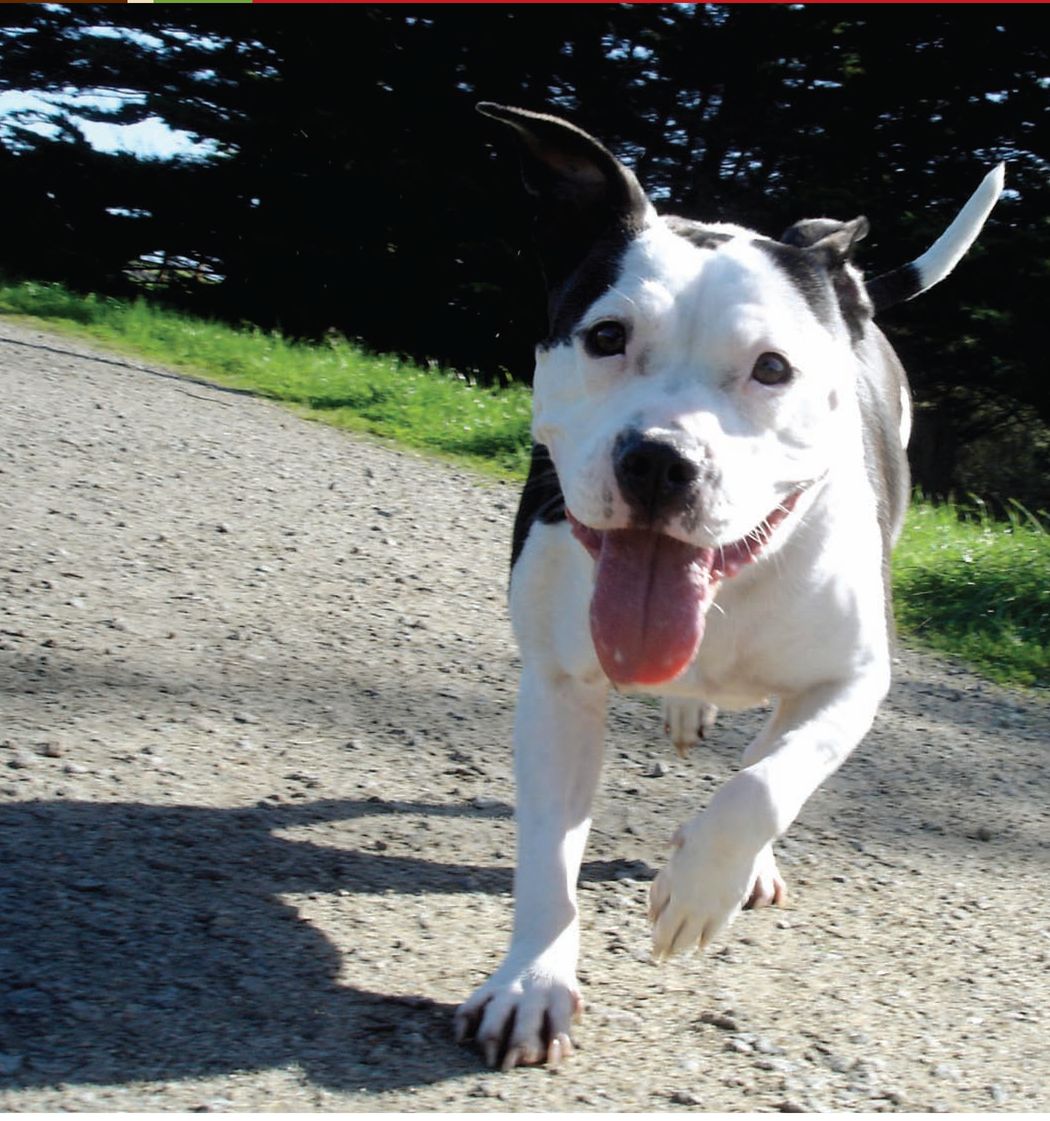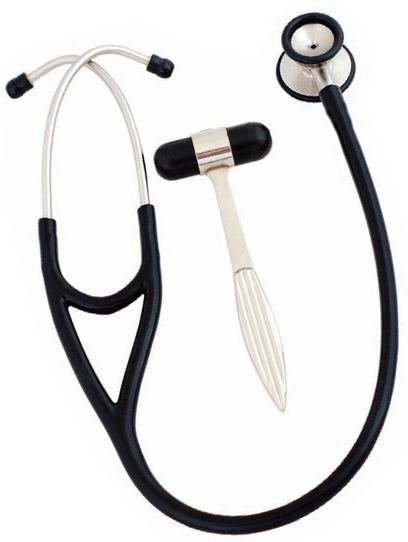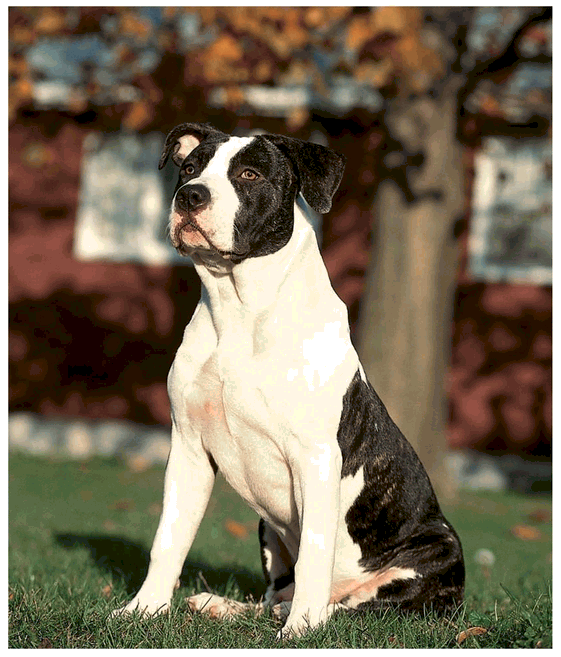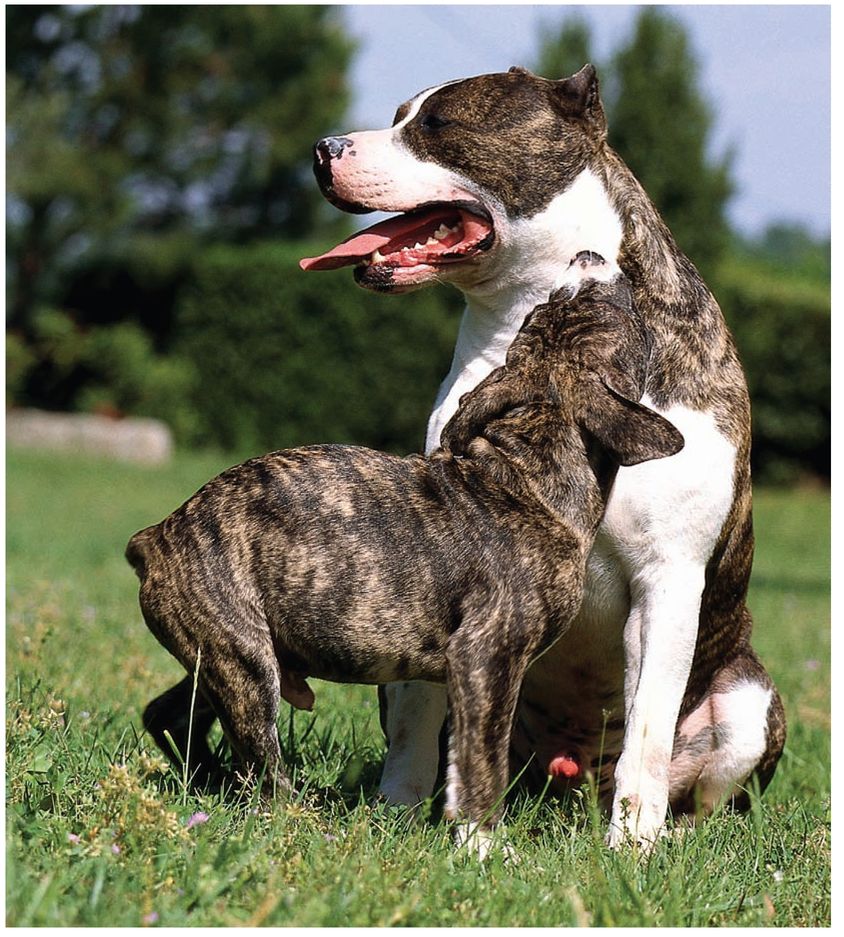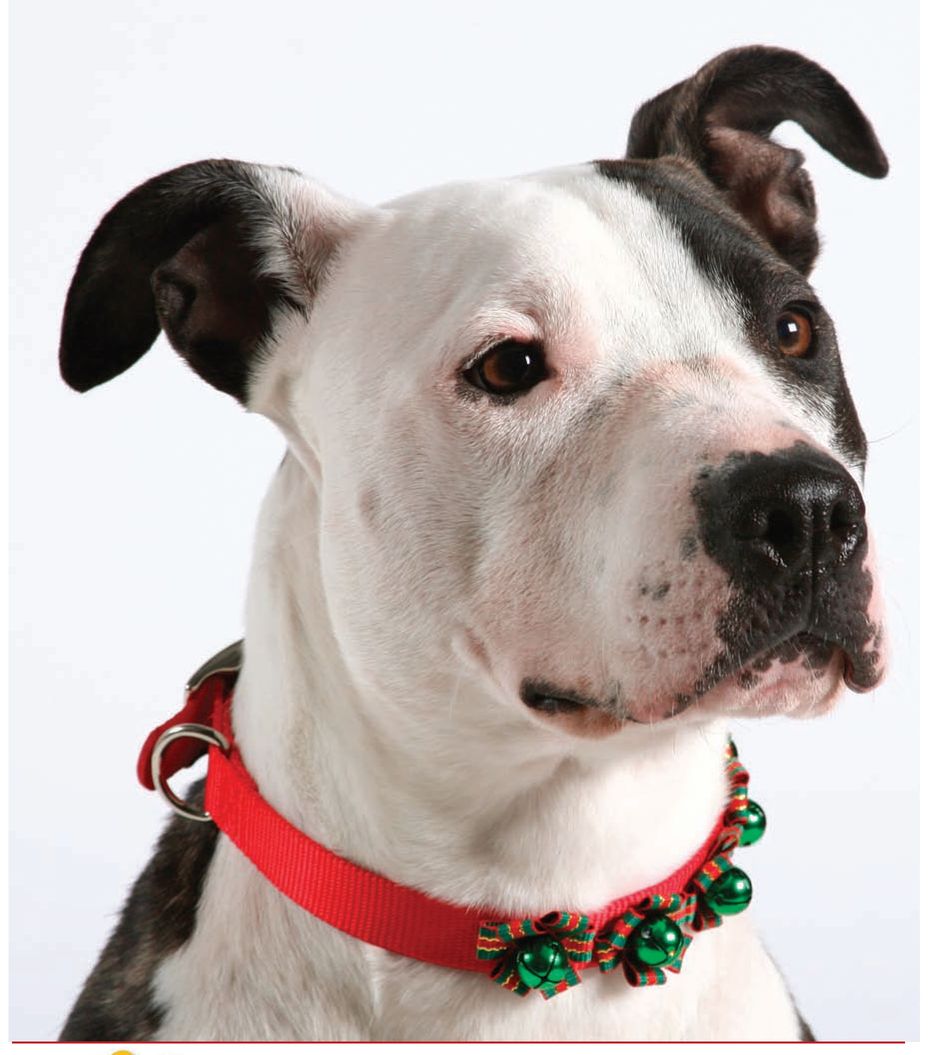CHAPTER 6
VET VISITS AND EVERYDAY CARE
Your selection of a veterinarian should be based on personal recommendation considering the doctor’s skills with dogs, and, if possible, specifically pit bulls. If the vet is based nearby, it will be helpful in the case of an emergency or need for multiple treatments.
FIRST STEP: SELECT THE RIGHT VET
All licensed veterinarians are capable of dealing with routine medical issues such as infections and injuries, as well as the promotion of health (for example, by vaccinations). If the problem affecting your APBT is more complex, your vet will refer you to someone with more detailed knowledge of what is wrong. This usually will be a specialist like a veterinary dermatologist, veterinary ophthalmologist or whichever specialty service you require.
Veterinary procedures are very costly and, as the treatments available improve, they are only going to become more expensive. It is quite acceptable to discuss matters of cost with your vet. If there is more than one treatment option, cost may be a factor in deciding which route to take.
Smart owners will look for a veterinarian before they actually need one. Newbie pet owners should start looking for a veterinarian a month or two before they bring home a new APBT puppy. That will give them time to meet candidate veterinarians, check out the condition of the clinic, meet the staff and see who they feel most comfortable with. If you already have an APBT puppy, look sooner rather than later, preferably not in the midst of a veterinary health crisis.
Second, define the criteria that are important to you. Points to consider or investigate:
Convenience: Proximity to your home, extended hours or drop-off services are helpful for people who work regular business hours, have a busy schedule or do not want to drive far. If you have mobility issues, finding a vet who makes house calls or a service that provides pet transport might be particularly important.
Size: A one-person practice ensures that you will always deal with the same vet during each and every visit. “That person can really get to know both you and your dog,” says Bernadine Cruz, D.V.M., of Laguna Hills Animal Hospital in Laguna Hills, Calif. The downside, though, is that the sole practitioner does not have the immediate input of another vet, and if your vet becomes ill or takes time off, you are out of luck.
The multiple-doctor practice offers consistency if your pit bull needs to come in unexpectedly on a day when your veterinarian isn’t there. Additionally, your vet can quickly consult with his colleagues within the clinic if he’s unsure about a diagnosis or a treatment.
If you find a veterinarian within that practice who you really like, you can make your appointments with that individual, establishing the same kind of bond that you would with a solo practitioner.
Appointment Policies: Some vet practices are strictly by-appointment only, which could minimize your wait time. However, if a sudden problem arises with your APBT and the veterinarians are booked, they might not be able to squeeze your dog in that day. Some clinics are walk-in only, great for crisis or impromptu visits, but without scheduling may involve longer waits to see the next available veterinarian — whoever is open, not someone in particular. Some practices offer the best of both worlds by maintaining an appointment schedule but also keep slots open throughout the day for walk-ins.
Basic vs. State-of-the-Art vs. Full Service: A practice with high-tech equipment offers greater diagnostic capabilities and treatment options, important for tricky or difficult cases. However, the cost of pricey equipment is passed along to the client, so you could pay more for routine procedures — the bulk of most pets’ appointments. Some practices offer boarding, grooming, training classes and other services on the premises — conveniences some pet owners appreciate.
Picking the right vet is one of the most important decisions you’ll make for the lifelong health of your new family member. Make sure you ask the right questions to ensure that your vet is knowledgeable not only about dogs, but American Pit Bull Terriers in particular. Download a list of questions to ask potential vets by logging on to
DogChannel.com/Club-APBT — just click on “Downloads.”
Fees and Payment Polices: How much does a routine office call cost? If there is a significant price difference, ask why. If you intend to carry health insurance on your pit bull or want to pay by credit card, make sure the candidate clinic accepts those payment options.
FIRST VET VISIT
It is much easier, less costly and more effective to practice preventive medicine than to fight bouts of illness and disease. Properly bred puppies of all breeds come from parents who were selected based upon their genetic disease profile. The puppies’ mother should have been vaccinated, free of all internal and external parasites, and properly nourished. For these reasons, a visit to the veterinarian who cared for the dam (mother) is recommended if at all possible. The dam passes disease resistance to her puppies, which should last from eight to 10 weeks. Unfortunately, she can also pass on parasites and infection. This is why knowledge about her health is useful in learning more about the health of the puppies.
Obesity is linked to an earlier onset of age-related health problems. Keep weight in check by providing sufficient exercise and play, and by feeding proper serving sizes. Calorie requirements decline as your puppy reaches adulthood and can drop 25 to 30 percent within a couple of months after your dog has been spayed or neutered; you’ll probably need to reduce serving portions and switch to a less calorie-dense diet.
Don’t wait until an illness or injury comes up. Schedule regular vet visits to be sure your pit bull is in tip-top form.
Now that you have your APBT puppy home safe and sound, it’s time to arrange your pup’s first trip to the veterinarian. Perhaps the breeder can recommend someone in the area who specializes in pit bulls, or maybe you know other APBT owners who can suggest a good vet. Either way, you should make an appointment within a couple of days of bringing home your puppy. If possible, see if you can stop by for this first vet appointment before going home.
The pup’s first vet visit will consist of an overall examination to make sure that he does not have any problems that are not apparent to you. The veterinarian also will set up a schedule for the pup’s vaccinations; the breeder will inform you of which ones the dog has already received and the vet can continue from there.
Your pit bull also will have his teeth examined and have his skeletal conformation and general health checked prior to certification by the veterinarian. Puppies in certain breeds have problems with their kneecaps, cataracts and other eye problems, heart murmurs and undescended testicles. They may also have personality problems; your veterinarian might even have training in temperament evaluation.
VACCINATION SCHEDULING
Most vaccinations are given by injection and should only be given by a veterinarian. Both you and the vet should keep a record of the date of the injection, the identification of the vaccine and the amount given. Some vets give a first vaccination at 8 weeks of age, but most dog breeders prefer the course not to commence until about 10 weeks because of interaction with the antibodies produced by the mother. The vaccination scheduling is usually based on a 15-day cycle. You must take your vet’s advice as to when to vaccinate, as this may differ according to the vaccine used.
The usual vaccines contain immunizing doses of several different viruses such as distemper, parvovirus, parainfluenza and hepatitis. There are other vaccines available when the puppy is at risk; you should rely on your vet’s advice. This is especially true for the booster immunizations. Most vaccination programs require a booster when the puppy is a year old and once a year thereafter. In some cases, circumstances may require more frequent immunizations.
Set up a vet visit before you even bring your new dog home, so you can meet and interview the veterinarian staff.
You need to exercise your dog. You need to keep your APBT socialized, and you need to give him leadership and direction. You need to not spoil him, but to teach him to learn things. — Rande Levine, Karma Rescue president from Los Angeles, Calif.
During your puppy’s first few weeks at home, take him to the vet just to meet the staff and so he gets comfortable with the office. Call ahead, though, to make sure it is safe, as puppies are more susceptible to infectious disease.
Kennel cough, more formally known as tracheobronchitis, is immunized with a vaccine that is sprayed into the dog’s nostrils. Kennel cough is usually included in routine vaccinations, but it’s usually not as effective as vaccines for other diseases.
Your veterinarian probably will recommend that your APBT puppy be fully vaccinated before you take him on outings. There are airborne diseases, parasite eggs in the grass and unexpected visits from other dogs that might be dangerous to your puppy’s health. Other dogs are the most harmful reservoir of pathogenic organisms, as everything they have can be transmitted to your puppy.
6 Months to 1 Year of Age: Unless you intend to breed or show your dog, neutering/ spaying your puppy at 6 months of age is recommended. Discuss this with your veterinarian. Neutering/spaying has proven to be beneficial to male and female puppies, respectively. Besides eliminating the possibility of pregnancy, it inhibits (but does not prevent) breast cancer in females and prostate cancer in male dogs.
Your veterinarian should provide your APBT puppy with a thorough dental evaluation at 6 months, ascertaining whether all his permanent teeth have erupted properly. A home dental care regimen should be initiated at 6 months, including brushing weekly and providing good dental devices (such as nylon bones). Regular dental care promotes healthy teeth, fresh breath and a longer life.
Pits have so many qualities not present in other breeds, and the love and loyalty they offer to their people is unexplainable. They are abused, neglected and tortured more frequently and in more horrific ways than any other breed; yet, they possess more affection and loyalty than any human could even imagine. — Amanda Conrad, president of Pit Prints Pit Bull Rescue/Rehabilitation in Canton, Ga.
When selecting a veterinarian, make sure he or she is familiar with American Pit Bull Terriers.
Dogs Older Than 1 Year: Continue to visit the veterinarian at least once a year. There is no such disease as “old age,” but bodily functions do change as your dog gets older. The eyes and ears are no longer as efficient; liver, kidney and intestinal functions often decline; and proper dietary changes, recommended by your veterinarian, can make life more pleasant for your aging APBT and you.
EVERYDAY HAPPENINGS
Keeping your pit bull healthy is a matter of keen observation and quick action when necessary. Knowing what’s normal for your dog will help you recognize signs of trouble before they blossom into a full-blown emergency situation.
Even if the problem is minor, such as a cut or scrape, you’ll want to care for it immediately to prevent infection, as well as to ensure that your dog doesn’t make it worse by chewing or scratching at it. Here’s what to do for common, minor injuries or illnesses and how to recognize and deal with emergencies.
Vets aren’t just for vaccinating puppies; adult dogs need regular checkups, too.
Just like with infants, puppies need a series of vaccinations to ensure that they stay healthy during their first year of life. Download a vaccination chart from
DogChannel.com/Club-APBT that you can fill out for your American Pit Bull Terrier.
Cuts and Scrapes: For a cut or scrape that’s half an inch or smaller, clean the wound with saline solution or warm water and use tweezers to remove any splinters or other debris. Apply antibiotic ointment. No bandage is necessary unless the wound is on a paw, which can pick up dirt when your dog walks on it. Deep cuts with lots of bleeding or those caused by glass or some other object should be treated by your veterinarian.
Cold Symptoms: Dogs don’t actually get colds, but they can get illnesses that have similar symptoms, such as coughing, a runny nose or sneezing. Dogs cough for any number of reasons, from respiratory infections to inhaled irritants to congestive heart failure. Take your APBT to the veterinarian for prolonged coughing or coughing accompanied by labored breathing, runny eyes or nose or bloody phlegm.
A runny nose that continues for more than several hours requires veterinary attention, as well. If your American Pit Bull Terrier sneezes, he may have some mild nasal irritation that will go away on its own, but frequent sneezing, especially if it’s accompanied by a runny nose, may indicate anything from allergies to an infection to something stuck in the nose.
Vomiting and Diarrhea: Sometimes dogs suffer minor gastric upsets when they eat a new type of food, eat too much, eat the contents of the trash can or become excited or anxious. Give your pit bull’s stomach a rest by withholding food for 12 hours, and then feeding him a bland diet such as baby food or rice and chicken, gradually returning your APBT to his normal food. Projectile vomiting, or vomiting or diarrhea that continues for more than 48 hours, is another matter. If this happens, take your APBT to the veterinarian.
MORE HEALTH HINTS
An APBT’s anal glands can cause problems if not evacuated periodically. In the wild, anal glands are cleared regularly to set the dog’s mark, but in domestic dogs this function is no longer necessary; thus, their contents can build up and clog, causing discomfort. Signs that the anal glands on either side of the anus need emptying are if a APBT drags his rear end along the ground or keeps turning around to attend to the uncomfortable patch.
While care must be taken not to cause injury, anal glands can be evacuated by pressing gently on either side of the anal opening and by using a piece of cotton or a tissue to collect the foul-smelling matter. If anal glands are allowed to become impacted, abscesses can form, causing pain and the need for veterinary attention.
APBTs can get into all sorts of mischief, so it’s not uncommon for them to inadvertently swallow something poisonous in the course of their investigations. Obviously, an urgent visit to your vet is required under such circumstances, but if possible, when you telephone him or her, you should advise which poisonous substance has been ingested, as different treatments are needed. Should it be necessary to cause your dog to vomit (which is not always the case with poisoning), a small lump of baking soda, given orally, will have an immediate effect. Alternatively, a teaspoon of salt or mustard, dissolved in water, will have a similar effect but may be more difficult to administer and not as quick in its action.
APBT puppies often have painful fits while they are teething. These are not usually serious and are fleetingly brief, caused only by the pain of teething. Of course you must be certain that the cause is not more serious, but giving a puppy something hard to chew on will usually be enough to solve this temporary problem.
No matter how careful you are with your precious pit bull, sometimes unexpected injuries happen. Be prepared for any emergency by creating a canine first-aid kit. Find out what essentials you need on
DogChannel.com/Club-APBT. Click on “Downloads.”
